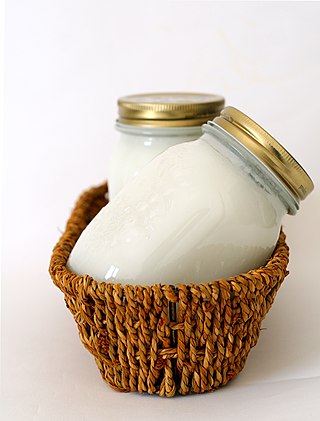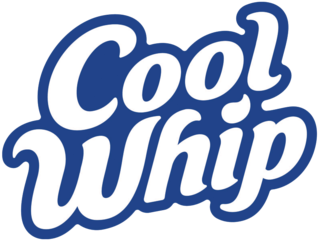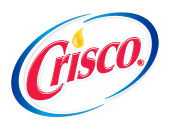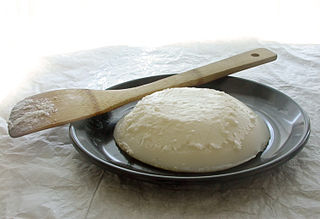
Nutella is a brand of brown, sweetened hazelnut cocoa spread. Nutella is manufactured by the Italian company Ferrero and was introduced in 1964, although its first iteration dates to 1963.

Splenda is a global brand of sugar substitutes and reduced-calorie food products. While the company is known for its original formulation containing sucralose, it also manufactures items using natural sweeteners such as stevia, monk fruit and allulose. It is owned by the American company Heartland Food Products Group. The high-intensity sweetener ingredient sucralose used in Splenda Original is manufactured by the British company Tate & Lyle.

A muffin is an individually portioned baked product; however, the term can refer to one of two distinct items: a part-raised flatbread that is baked and then cooked on a griddle, or a quickbread that is chemically leavened and then baked in a mold. While quickbread "American" muffins are often sweetened, there are savory varieties made with ingredients such as corn and cheese, and less sweet varieties like traditional bran muffins. The flatbread "English" variety is of British or other European derivation, and dates from at least the early 18th century, while the quickbread originated in North America during the 19th century. Both types are common worldwide today.

Shortening is any fat that is a solid at room temperature and is used to make crumbly pastry and other food products.

Crystal Light is an American brand of powdered and artificially sweetened beverage mixes produced by Kraft Heinz. It was introduced in 1982 to a test market and released to the public in April 1984. General Foods, a now defunct company, were the original sellers of the product, but now it is sold by Kraft Foods. It is available in a wide variety of flavors, such as lemonade, sweet tea, and fruit punch.

Cool Whip is an American brand of whipped topping manufactured by Kraft Heinz. It is used in North America as a topping for desserts, and in some no-bake pie recipes as a convenience food or ingredient that does not require physical whipping and can maintain its texture without melting over time.

Lay's is a brand of potato chips with different flavors, as well as the name of the company that founded the chip brand in the United States. The brand is also referred to as Frito-Lay, as both Lay's and Fritos are brands sold by the Frito-Lay company, which has been a wholly owned subsidiary of PepsiCo since 1965.

Crisco is an American brand of shortening that is produced by B&G Foods. Introduced in June 1911 by Procter & Gamble, it was the first shortening to be made entirely of vegetable oil, originally cottonseed oil. Additional products marketed under the Crisco brand include a cooking spray, various olive oils, and other cooking oils, including canola, corn, peanut, sunflower, and blended oils.

Bontan Rice Candy is a specific brand of a category of Japanese candy called bontan ame (ボンタンアメ). Bontan ame are soft, chewy, citrus-flavored candy with an outer layer of rice paper or Oblaat. The rice paper is clear and plastic-like when dry, but it is edible and dissolves in the mouth. This candy was invented by Seika Foods in 1924. During this period, more and more Western-style sweets were becoming popular in Japanese society, and the appearance of this type of candy is intentionally similar to Western-style caramel candies. In Japan, these candies are sold as Dagashi, cheap candies and snacks marketed to Japanese schoolchildren, and are often in small sizes with bright colorful packaging with stickers or prizes included.
Cooking spray is a spray form of an oil as a lubricant, lecithin as an emulsifier, and a propellant such as nitrous oxide, carbon dioxide or propane. Cooking spray is applied to frying pans and other cookware to prevent food from sticking. Traditionally, cooks use butter, shortening, or oils poured or rubbed on cookware. Most cooking sprays have less food energy per serving than an application of vegetable oil, because they are applied in a much thinner layer: US regulations allow many to be labelled "zero-calorie"; in the UK sprays claim to supply "less than 1 calorie per serving". Popular US brands include Pam, Crisco, and Baker's Joy. Sprays are available with plain vegetable oil, butter and olive oil flavor.
Peppermint extract is a herbal extract of peppermint made from the essential oil of peppermint leaves. Peppermint is a hybrid of water mint and spearmint. The oil has been used for various purposes over centuries.

Corn chowder is a chowder soup prepared using corn as a primary ingredient. Basic corn chowder is commonly made of corn, onion, celery, milk or cream, and butter. Additional ingredients sometimes used include potatoes or squash, salt pork, fish, seafood and chicken. In the United States, recipes for corn chowder date to at least as early as 1884. Corn chowder is mass-produced as a canned food in the U.S.
Sani-Flush was an American brand of crystal toilet bowl cleaner formerly produced by Reckitt Benckiser. Its main ingredient was sodium bisulfate; it also contained sodium carbonate as well as sodium lauryl sulfate, talc, sodium chloride, fragrance and dye.

Wheatena is an American high-fiber, toasted-wheat cereal that originated on Mulberry Street in New York City, New York, c. 1879, when a small bakery owner began roasting whole wheat, grinding it, and packaging it for sale under this brand name.

Lard is a semi-solid white fat product obtained by rendering the fatty tissue of a pig. It is distinguished from tallow, a similar product derived from fat of cattle or sheep.

ReaLemon is an American brand of lemon juice that debuted in 1934, and is manufactured and marketed as of 2016 by Mott's, part of Keurig Dr Pepper. ReaLime is a brand of lime juice that debuted in 1944, is produced in the same manner as ReaLemon, and is also produced and marketed by Mott's.

Instant pudding is an instant food product that is manufactured in a powder form and used to create puddings and pie filling. It is produced using sugar, flavoring agents and thickeners as primary ingredients. Instant pudding can be used in some baked goods.

Velveeta Shells & Cheese is a shell pasta and cheese sauce food product that debuted in the United States in 1984, as part of the Velveeta brand products. Its ingredients, texture, and flavor are very similar to macaroni and cheese. The product is a shelf-stable food.

International Home Foods (IHF) was an American manufacturer, distributor and marketer of food products, based in Parsippany, New Jersey. It was acquired in 2000 by ConAgra Foods and merged into ConAgra's Grocery Products division. IHF's best known brands were Chef Boyardee pasta products, Bumble Bee Seafood, PAM cooking spray, and Gulden's mustard.
















